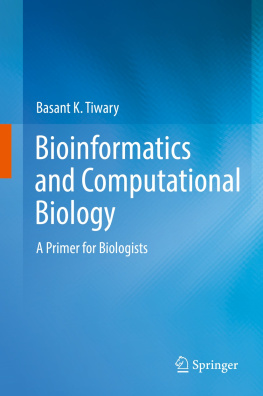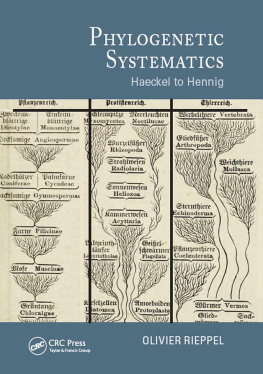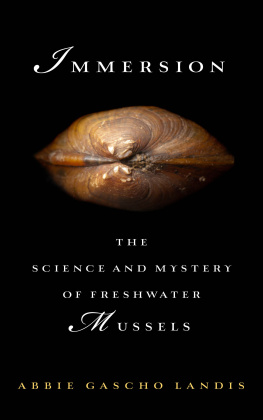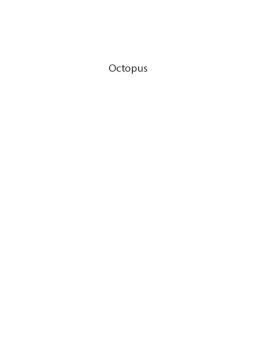CONTENTS

INVERTEBRATE ZOOLOGY
Bernd Schierwater is Director of the Institute of Animal Ecology and Evolution, University of Veterinary Medicine Hannover, Foundation. Bernd does research in developmental biology, ecology, and evolutionary biology. His current projects are the urmetazoan puzzle, placozoan systematics and genomics, and next-generation biomonitoring of global change.
Rob DeSalle is Curator at the Sackler Institute of Comparative Genomics in the Division of Invertebrate Zoology at the American Museum of Natural History. Rob works in molecular systematics, microbial evolution, and genomics. His current research concerns the development of bioinformatic tools to handle large-scale genomics problems using phylogenetic systematic approaches.
Note: Locators in italics represent figures and bold indicate tables in the text.
A
Aberrant Gastrotricha,
Acanella eburnea,
Acanthaster planci,
Acanthobdellida,
Acanthocephala,
database and collections,
development,
distribution and ecology,
genetics,
history and systematics,
life cycle,
male and female acanthocephalans,
morphology and anatomy,
physiology and behavior,
reproduction,
scanning electron micrographs,
Tree of Life (ToL), position in,
Acanthoecida,
Acariformes,
Acelomate,
Aciculata,
Acoela hypothesis,
Acoelomata,
Acoelomorpha,
Acoels,
Actiniaria,
Actinomyxidia,
Actinosporea,
Actinulida,
Aculifera,
AGALMA,
Aglaja diomedea,
Alatina moseri,
Alcyonacea,
Altocrustacea,
Alvinella pompejana,
Amblypygi,
Ambulacraria,
Ameobozoa,
Americobdellidae,
Americobdelliformes,
Amiskwia,
Amorphea,
Amphiblastula,
Amphimedon sp.,
A. queenslandica,
Amphineura,
Amphinomida,
Amphioxus lanceolatus,
Amphipholis
A. linopneusti,
A. squamata,
Amphiporus lacteus,
Amphiura filiformis,
Amplexidiscus fenestrafer,
Amplicon versus shotgun sequencing,
Anasca,
Anascan cheilostome ectoprocts,
Anatomical techniques for examining invertebrates,
Anchors,
Ancylostoma duodenale,
Annelida,
anatomy, histology, and morphology,
databases and collections,
developmental genes,
ecology and geographic distribution,
feeding,
locomotion,
genetics and genomics,
history of taxonomy and classification,
phylogenetic hypothesis,
physiology and behavior
behavior,
digestion,
respiration,
reproduction,
Tree of Life (ToL), position in,
Anoxia,
Antarctonemertes,
Anthoathecata,
Anthozoa,
anatomy, histology and morphology,
asexual reproduction,
databases and collections,
developmental genes,
distribution and ecology,
genetics and genomics,
history of taxonomy and classification,
phylogenetic tree,
physiology and behavior,
recommendations for NGS success,
sexual reproduction,
Tree of Life (ToL), position in,
Antipatharia,
Antipathella subpinnata,
Aphrodite acuteata,
Apicomplexa,
Aplanulata,
Aplidium albicans,
Aplousobranchia,
Apostichopus sp.
A. japonicus,
A. parvimensis,
Appendicularian, development of,
Apusomonads,
Arabidopsis thaliana,
Arachnida,
Arachnopulmonata,
Araneae,
Archaeognatha,
Archisymplectes,
Archoophora,
Arcoophora,
Arenonemertes,
Arhynchobdellida,
Arhynchonemertes axi,
Aristotle,
Aristotle matrix,
Aristotle.nex matrix, analyzing,
Aristotle's lantern,
Armorloricus elegans,
Artemia,
Arthropoda,
anatomy, histology, and morphology,
databases and collections,
distribution and ecology,
genetics and genomics,
history of taxonomy and classification,
phylogenetic relationships,
physiology and behavior,
reproduction and development,
developmental genomics,
external fertilization,
internal fertilization,
parental care,
Tree of Life (ToL), position in,
Arthrotardigrada,
Ascaris
A. longissima,
A. lumbricoides,
Ascidiacea,
anatomy/morphology,
databases,
distribution and behavior,
ecology and physiology,
genomics and genetics,
history of taxonomy and classification,
reproduction, embryology, and larval anatomy,
Tree of Life (ToL), position in,
Ascidians,
Ascidian zooids,
Ascophora,
Assembly phase,
Asteroidea,
anatomy, histology, and morphology,
lifestyle,
phylogeny and classification,
reproduction and development,
Asterozoa,
Asymmetron,
Atelocerata,
atp8 gene,
Atrax robustus,
Aurelia sp.,
A. aurita,
Austrognathia,
B
Bagheera kiplingi,
Balanoglossus
B. aurantiacus,
B. clavigerus,
Barentsia gracilis,
Baseodiscus,
Basic Local Alignment Search Tool (BLAST),
Bathochordaeus,
Bathyhedyle boucheti,
Batillipes noerrevangi,
Bayes equation,
Bayesian approaches,
Bayesian Phylogenetic Inference,
Bdelloidea,
Beroe ovata,
Bifurcation,
Bilateral symmetry,
Bilateria,
Bilaterian phyla, phylogenetic relationships of,
Binary discrete characters,
Biological species concept,
Biomphalaria sp.,
B. glabrata,
BioProjects,
Bioturbation,
Bivalvia,
Blastaea,
Blastomeres,
Boloceroides daphneae,
Bone morphogenetic protein (BMP)/decapentaplegic (Dpp) signaling pathway,
Bootstrapping,
Bothrioplana,
Bothrioplanida,
Botrylloides,
Botryllus sp.,
B. schlosseri,
Brachionus,
Brachiopoda,
anatomy,
behavior,
databases and collections,
ecology and distribution,
external morphology,
genetics,
history of classification,
internal anatomy,
physiology,
reproduction and development,
Tree of Life (ToL), position in,
Brachopoda,
Brachyury,
Branch,
Branchiobdellida,
Branchiopoda,
Branchiostoma sp.,
B. floridae,
B. lanceolatum,
B. lubricum,
Branchiura,
Bremer support (BS) measures,
Breviates,
Bryozoa,
Bryozoans,
Buddenbrockia plumaetellae,
Bursovaginoidea,
BUSCO (Benchmarking sets of Universal Single-Copy Orthologs),
Btschli, Otto,
Btschli's Placula hypothesis,
C
Caecosagitta macrocephala,
Caenorhabditis sp.,
C. elegans,
Calanus,
Calcarea,
Calcaronean sponges,
CalcaxoniaPennatulacea clade,
Calicogorgia granulosa,
Callinectes sp.,
C. ornatus,
C. sapidus,
Callogorgia spp.,
Camouflage,
Cancer pagurus,
Candidatus Endobugula sertula,
Candy cane sponge,










